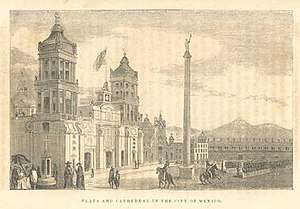Revolt of the Polkos
In February 1847, five Mexican National Guard regiments rose up in rebellion against the Mexican government, in protest over legislation that permitted the government to requisition money and property from the Catholic Church in Mexico. Led by General Matías Peña y Barragán, the group issued a set of demands which included the resignation of the President and Vice President of Mexico. When the demands were not met, fighting broke out in Mexico City. President Antonio López de Santa Anna was able to negotiate a peaceful solution with the rebels in March 1847.
| Revolt of the Polkos | |||||||
|---|---|---|---|---|---|---|---|
| Part of Mexican–American War | |||||||
 Plaza and Cathedral in Mexico City, 1847 | |||||||
| |||||||
| Belligerents | |||||||
|
|
| ||||||
| Commanders and leaders | |||||||
|
Matías Peña y Barragán José Mariano Salas Pedro María de Anaya |
Valentín Gómez Farías Antonio Lopez de Santa Anna | ||||||
Background
On January 11, 1847, Mexican vice president Valentín Gómez Farías, a liberal, signed legislation authorizing the government to requisition up to fifteen million pesos worth of Catholic Church property. This move which was intended to help finance the Mexican–American War drew criticism from conservatives, including the Catholic Church, large landowners, and military leaders. When National Guard units stationed in Mexico City expressed dissatisfaction with his policy, Gómez Farías ordered them to the front lines, a move that resulted in open rebellion.
Rebellion
On February 26, General Matías Peña y Barragán led five National Guard regiments in revolt. Other prominent members of the rebellion included José Mariano Salas and Pedro María de Anaya. The leaders of the rebellion issued a 13-point plan demanding the resignation of Gómez Farías as well as declaring the anti-clerical January law null. As the plan lost support, rebels reduced their demands to just one, the resignation of Gómez Farías. Members of the five National Guard units included sons of doctors, lawyers, merchants, and other elites. The rebels were known by their enemies as polkos, because they help the expansionist U.S. president who provoked the war, James K. Polk
Rejecting an offer of amnesty from Gómez Farías on the second day of the revolt, the rebels took control of several church buildings in Mexico City, while the government's forces controlled the National Palace, the cathedral, and the university, all located in central Mexico City. After ten days of street fighting, the rebels reduced their demands to only one: the removal of Gómez Farías from office.
On March 11, General Santa Anna, who was currently leading the Mexican Army on the front lines, sent troops to Mexico City to restore order. He returned to the capital soon after, and forged a peace settlement with Peña y Barragán and the other leaders of the rebellion. He made a political calculation under difficult circumstances.[1] In the peace settlement, Congress abolished the office of vice president, thereby removing Gómez Farías from office, and named rebel leader Pedro Maria Anaya "substitute president." Santa Anna also agreed to the repeal of the January 11 law in exchange for a donation of 1.5 million pesos from the Church to fund the war effort. Santa Anna succeeded in getting the church to aid the army's war effort against the invading U.S. Army.
The revolt reaffirmed the high degree of influence which the Catholic Church and conservatives exerted over the republic of Mexico. It also exposed long-standing rifts among Mexico's political elites in wartime when unity was needed most in Mexico. The Catholic Church was concerned more with maintaining its privileges than Mexico's fight against the invasion. Santa Anna's intervention extracted a "donation" from the church rather than trying forcibly to take the funds. Santa Anna returned to the field to try to slow the invasion. He expressed his utter exasperation with the feuding politicians. "However shameful it is to admit this, we have brought this disgraceful tragedy upon ourselves through our interminable infighting."[2]
References
- Fowler, Santa Anna of Mexico, p. 265
- quoted in Fowler, Santa Anna of Mexico p. 265
Further reading
- Conway, Christopher, and Gustavo Pellon. The U.S.-Mexican War: A Binational Reader. Hackett Publishing, 2010, 116.
- Costeloe, Michael P. "The Mexican Church and the Rebellion of the Polkos." The Hispanic American Historical Review 46, no. 2 (May 1, 1966): 170–178.
- Fowler, Will. Santa Anna of Mexico. Lincoln: University of Nebraska Press 2007.
- Frazier, Donald. The United States and Mexico at War: Nineteenth-Century Expansionism and Conflict. New York: Macmillan Reference USA, 1998, 329.
- Heidler, David Stephen, and Jeanne T. Heidler. The Mexican War. Greenwood Publishing Group, 2006, 113-115.
- Howe, Daniel Walker. What Hath God Wrought: The Transformation of America, 1815–1848. New York: Oxford University Press US, 2007, 781–782.
- MacLachlan, Colin M., and William H. Beezley. Mexico's Crucial Century, 1810–1910: An Introduction. Lincoln, NE: University of Nebraska Press, 2011, 62–74.
- Santoni, Pedro. Mexicans at Arms: Puro Federalists and the Politics of War, 1845–1848. Fort Worth: Texas Christian University Press, 1996, 182–195.